
Pirates & Sea
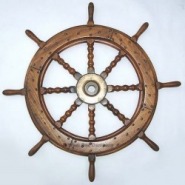
A pirate Throughout history, there have been people willing to rob others transporting goods on the water. Thousands of pirates were active from 1650–1720. These years are sometimes known as a 'Golden Age' of piracy. In some parts of the world, especially the South China Seas, piracy still exists today.
What is a pirate?
A pirate is a robber who travels by water. Though most pirates targeted ships, some also launched attacks on coastal towns.Pirates have existed since ancient times. They threatened the trading routes of ancient Greece, and seized cargoes of grain and olive oil from Roman ships. Pirates were sometimes known as corsairs or buccaneers.
Who were the corsairs?
Corsairs were pirates who operated in the Mediterranean Sea between the 15th and 18th centuries. Muslim corsairs, such as the daring Barbarossa (red beard) brothers, had bases along the Barbary coast of north Africa. They built many strong fortresses to defend the Barbary ports of Algiers, Tripoli and Tunis. Christian corsairs were based on the island of Malta. Muslim and Christian corsairs alike swooped down on their targets in swift oar-powered boats called galleys to carry off sailors and passengers. Unless these unfortunates were rich enough to pay a ransom, they were sold as slaves or put to work as oarsmen on the corsair galleys.
Who were the buccaneers?
In the 17th century, buccaneers lived on the Caribbean island of Hispaniola and its tiny turtle-shaped neighbour, Tortuga. At first, they lived as hunters, and shot wild pigs with their long-barrelled muskets. Their name came from the special wooden huts called boucans where they smoked their meat.
Later, the governors of Caribbean islands such as Jamaica paid the buccaneers to attack Spanish treasure ships and ports. Some of the largest scale raids were led by the Welsh captain, Sir Henry Morgan. Although raids began in this way, with official backing, the buccaneers gradually became more and more out of control, eventually attacking any ship they thought carried valuable cargo, whether it belonged to an enemy country or not. The buccaneers had become true pirates.
The explorer Christopher Columbus established contact between Europe and the lands that were later named America at the end of the 15th century, while searching for a quick route to the east.As he was working for the king and queen of Spain, these 'new lands' were claimed by the Spanish, who soon discovered them to be a rich source of silver, gold and gems. From the 16th century, large Spanish ships, called galleons, began to sail back to Europe, loaded with precious cargoes that pirates found impossible to resist. So many successful pirate attacks were made that galleons were forced to sail together in fleets with armed vessels for protection. As Spanish settlers set up new towns on Caribbean islands and the American mainland, these too came under pirate attack.
Pirate ships usually carried far more crew than ordinary ships of a similar size. This meant they could easily outnumber their victims. Pirates altered their ships so that they could carry far more cannon than merchant ships of the same size. Stories about pirate brutality meant that many of the most famous pirates had a terrifying reputation, and they advertised this by flying various gruesome flags including the 'Jolly Roger' with its picture of skull and crossbones. All these things together meant that victims often surrendered very quickly. Sometimes there was no fighting at all. As well as being heavily armed with knives, cutlasses and pistols, Blackbeard tried to make himself look especially fearsome in order to intimidate his victims. He had wild eyes and a mass of thick tangled hair. Into his hair he twisted pieces of fuse which he set alight during battles, so that his face was surrounded with smoke to create an even more terrifying image. The most precious prizes were chests of gold, silver and jewels. Coins were especially popular because pirate crews could share them out easily. Coins were far more likely to be made of silver than gold, because ten times as much silver was mined in America, but wealthy passengers were sometimes robbed of gold doubloons they brought with them from Spain.Emeralds and pearls were the most common jewels that were mined in America and provided rich plunder. However, pirates did not only seize precious cargoes like these. They also wanted things they could use, such as food, barrels of wine and brandy, sails, anchors and other spare equipment for their ship, and essential tools such as those belonging to the ship's carpenter and surgeon.
Pirates Henry Avery
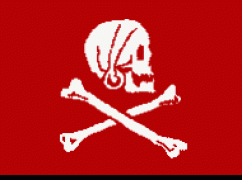
Henry Avery (Long Ben/Capt. Bridgeman)
Avery is recorded as having two different flags that feutured the same skull and crossbones design with the only difference being a red or black background. His flag could be considered somewhat of a "standard" pirate flag since it had the typical skull-and-crossbones, although the skull design is a little more elaborate.
Christopher Moody
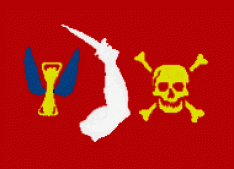
Christopher Moody Definitely one of most colorful pirate flags, Moody's flag consisted of three typical pirate symbols - skull-and-crossbones, the hourglass (winged even), and the sword.
Edward England
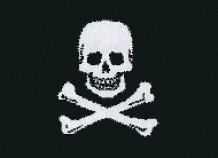
Edward England England's flag is probably what is considered today THE standard pirate flag - simply skull-and-crossbones on black.
Thomas Tew
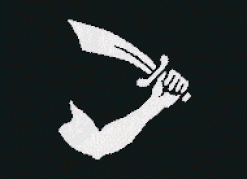
Thomas Tew Tew's flag had neither skulls nor bones, but simply an arm wielding a sword signifying power.
John Rackam (Calico Jack)
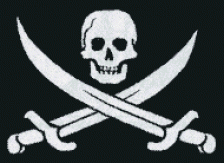
John Rackam (Calico Jack) Rackham's flag was another typical looking pirate flag with somewhat large crossed cutlasses instead of bones.
